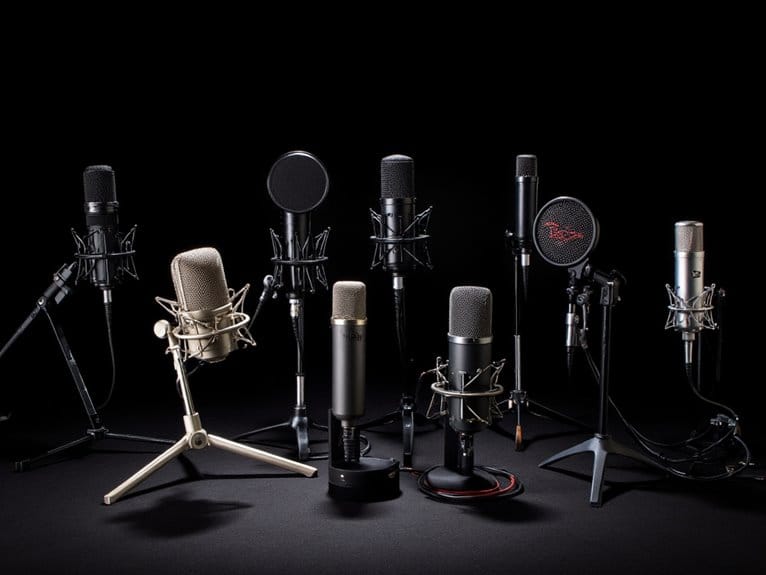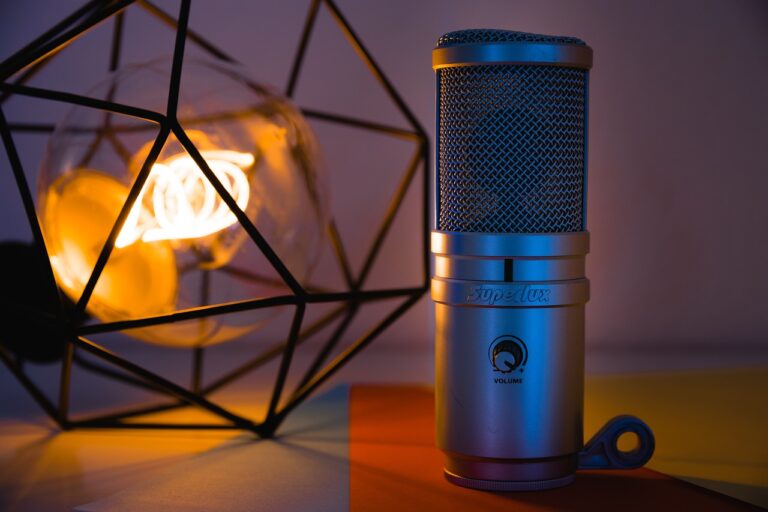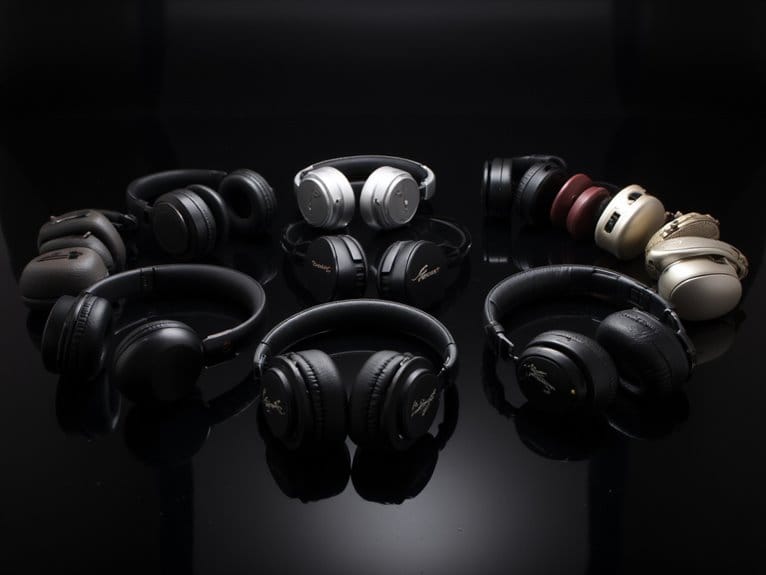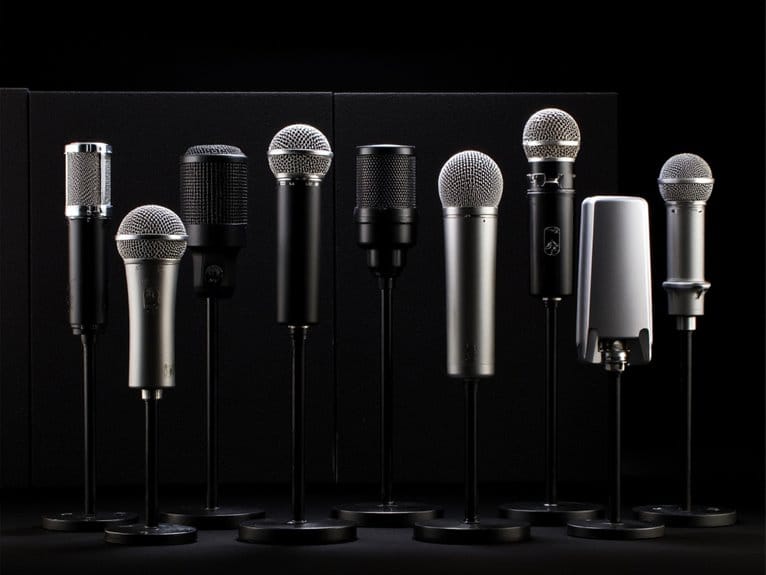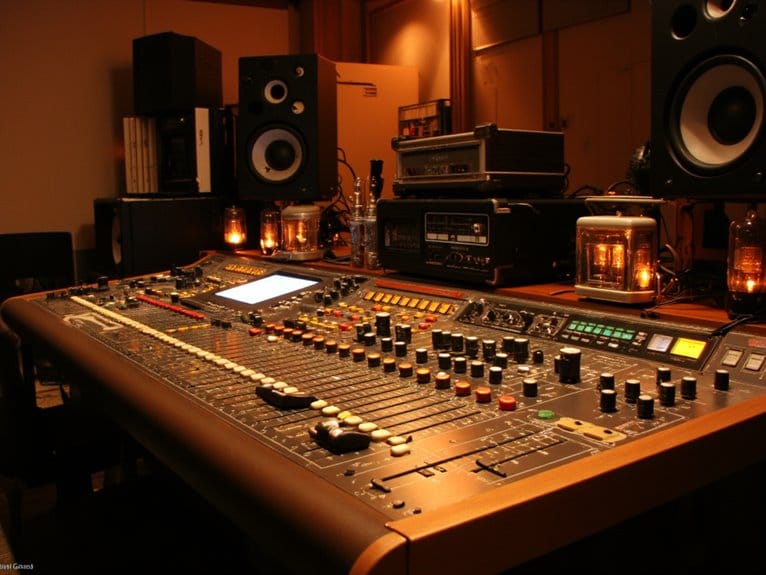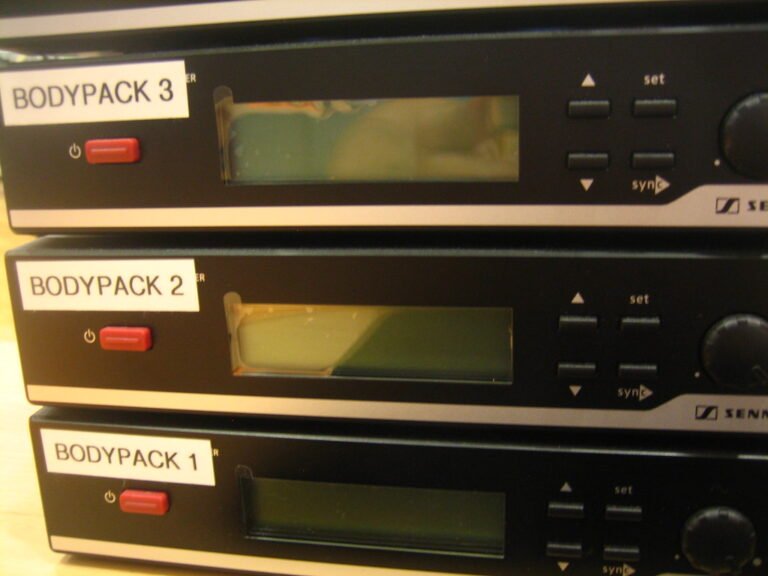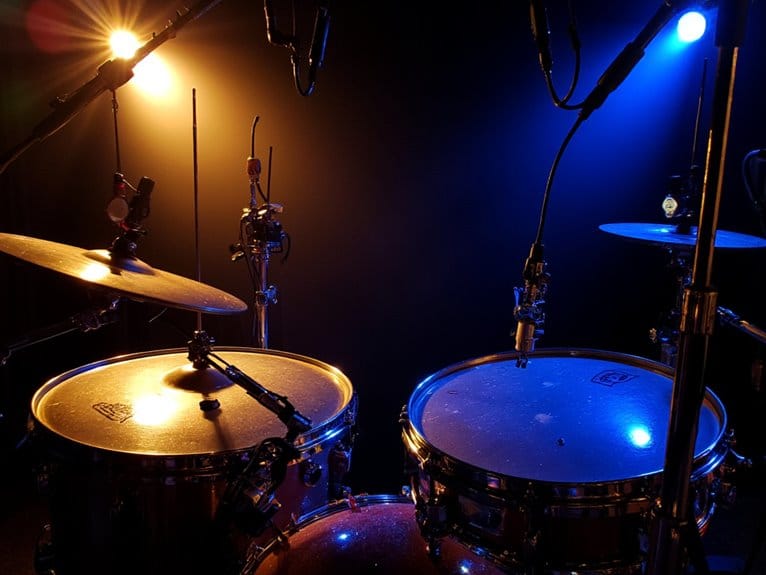10 Best Streaming Microphones for Crystal Clear Audio
After testing dozens of streaming microphones, I recommend the FIFINE AM8T for versatility with dual XLR/USB connectivity, Blue Yeti for its broadcast-quality three-capsule array and four pickup patterns, and HyperX QuadCast S for RGB aesthetics with excellent noise reduction. Budget-conscious streamers should consider the HyperX SoloCast’s 24-bit/96kHz recording capability, while the FIFINE AM8 offers effective noise rejection for dynamic recording. Each microphone delivers distinct advantages depending on your setup requirements, budget constraints, and specific streaming applications you’ll discover below.
We are supported by our audience. When you purchase through links on our site, we may earn an affiliate commission, at no extra cost for you. Learn more.
Notable Insights
- The Blue Yeti offers broadcast-quality audio with four pickup patterns and onboard controls for versatile streaming applications.
- FIFINE AM8T provides dual XLR/USB connectivity with 80dB signal-to-noise ratio for professional flexibility and clear voice reproduction.
- HyperX QuadCast S features customizable RGB lighting, four polar patterns, and effective noise reduction for engaging streaming setups.
- Mid-range microphones ($100-150) deliver optimal value with professional audio quality, easy setup, and long-term reliability for streamers.
- Essential specifications include 50Hz-20kHz frequency response, 80dB+ signal-to-noise ratio, and cardioid polar patterns for crystal-clear audio.
FIFINE XLR/USB Gaming Microphone Set (AM8T)

The FIFINE AM8T stands out as an exceptional choice for budget-conscious streamers who need professional-grade audio without breaking the bank, offering dual XLR/USB connectivity that adapts to your current setup while providing room for future upgrades. You’ll appreciate the crystal-clear vocal reproduction through its cardioid polar pattern, which effectively suppresses background noise with -50dB sensitivity and an impressive 80dB signal-to-noise ratio. The included boom arm and desk clamp accommodate desktops up to two inches thick, though I’ve noticed some users recommend upgrading the arm for peak performance. With its 50Hz-16kHz frequency range and plug-and-play compatibility, you’re getting professional streaming capabilities without complicated software requirements.
Best For: Budget-conscious streamers, podcasters, and content creators who want professional-grade audio quality with dual connectivity options and room for future equipment upgrades.
Pros:
- Dual XLR/USB connectivity provides flexibility for current setups and future upgrades to professional audio interfaces
- Excellent noise suppression with cardioid polar pattern, -50dB sensitivity, and 80dB signal-to-noise ratio for clear vocal recording
- Plug-and-play setup with no proprietary software required, compatible with popular streaming platforms and software
Cons:
- High frequencies can sound piercing and may require audio adjustments or EQ settings
- Boom arm may produce noise and vibration issues, with some users recommending upgrades or modifications
- XLR cable not included despite advertising XLR connectivity, requiring separate purchase for full functionality
Blue Yeti USB Mic for Recording and Streaming (Blackout)

Content creators who demand broadcast-quality audio without the complexity of professional studio equipment will find the Blue Yeti USB Microphone an exceptional choice, particularly since its custom three-capsule array delivers remarkably clear sound that rivals much more expensive setups. You’ll appreciate the four pickup patterns-cardioid, omni, bidirectional, and stereo-which eliminate the need for multiple microphones in most recording scenarios, while onboard controls for headphone volume, pattern selection, and instant mute provide immediate audio adjustments during streams. The plug-and-play setup works seamlessly with both PC and Mac systems, though you should note that its sensitivity occasionally picks up vibrations from your desk.
Best For: Content creators, podcasters, streamers, and musicians who need professional-quality audio recording with versatile pickup patterns and simple plug-and-play setup.
Pros:
- Four versatile pickup patterns (cardioid, omni, bidirectional, stereo) eliminate the need for multiple microphones in most recording scenarios
- Onboard controls for headphone volume, pattern selection, instant mute, and mic gain provide real-time audio adjustments during recording or streaming
- Simple plug-and-play setup works seamlessly with both PC and Mac without requiring complex installation or professional studio equipment
Cons:
- High sensitivity can pick up unwanted vibrations from desk surfaces during recording
- Relatively large size (10.5 x 8.4 x 7.5 inches) and weight (3.51 pounds) may require sturdy desk space or boom arm support
- May be overly sensitive for users in noisy environments without proper acoustic treatment
FIFINE USB/XLR Dynamic Microphone for Podcast Recording (AM8)

Versatility defines the FIFINE AM8’s greatest strength, as this dynamic microphone delivers dual USB and XLR connectivity that adapts seamlessly to both beginner setups and professional audio interfaces. You’ll appreciate the cardioid pickup pattern that effectively rejects background noise, while the 50Hz-16KHz frequency response captures clear vocal reproduction for streaming applications. The built-in headphone monitoring with volume controls eliminates guesswork during live broadcasts, and I’ve found the tap-to-mute function with LED indicator particularly useful for maintaining privacy. RGB lighting adds visual appeal with customizable colors and memory retention, though some users report initial volume concerns that proper gain adjustment typically resolves.
Best For: Content creators, podcasters, and streamers who need a versatile microphone that works with both USB plug-and-play setups and professional XLR audio interfaces while providing reliable background noise rejection.
Pros:
- Dual USB/XLR connectivity offers flexibility for beginner and professional setups without requiring additional adapters
- Cardioid pickup pattern effectively rejects background noise and delivers clear vocal reproduction in untreated environments
- Built-in headphone monitoring with volume controls and tap-to-mute function with LED indicator enhances live streaming workflow
Cons:
- Some users experience initial low volume issues that require proper gain adjustment and software configuration
- Limited frequency response range of 50Hz-16KHz may not capture the full spectrum compared to higher-end microphones
- RGB lighting feature, while visually appealing, may be unnecessary for users focused purely on audio quality
HyperX QuadCast S RGB USB Condenser Microphone for PC, PS4, PS5 and Mac

Gaming streamers who demand both exceptional audio quality and eye-catching aesthetics will find their perfect match in the HyperX QuadCast S RGB USB Condenser Microphone, which combines professional-grade recording capabilities with customizable RGB lighting effects that sync beautifully with gaming setups. You’ll appreciate the four selectable polar patterns-stereo, omnidirectional, cardioid, and bidirectional-that adapt to different recording scenarios, while the built-in anti-vibration shock mount effectively suppresses unwanted noise. The tap-to-mute sensor with LED indicator provides instant audio control, and with its 20 Hz to 20 kHz frequency response delivering crisp clarity, this microphone consistently earns praise from over 17,000 users who’ve rated it 4.7 stars.
Best For: Gaming streamers, content creators, and podcasters who want professional audio quality with customizable RGB lighting and versatile recording options across multiple platforms.
Pros:
- Four selectable polar patterns (stereo, omnidirectional, cardioid, bidirectional) provide versatility for different recording scenarios
- Built-in anti-vibration shock mount and pop filter effectively reduce unwanted noise and plosive sounds
- Convenient tap-to-mute sensor with LED indicator and customizable RGB lighting effects enhance both functionality and aesthetics
Cons:
- Some users report challenges with background noise pickup, requiring careful positioning or headset use
- At 1.32 pounds, it may be heavier than some users expect for desktop mounting
- RGB lighting customization requires HyperX Ngenuity software, adding an extra setup step
HyperX SoloCast USB Condenser Gaming Microphone

The HyperX SoloCast stands out as a budget-conscious streamer’s dream, delivering professional-grade audio quality through its 24-bit/96 kHz recording capability without the premium price tag that typically accompanies such specifications. You’ll appreciate its cardioid polar pattern, which effectively captures your voice while minimizing background distractions, and the convenient tap-to-mute sensor with LED indicator eliminates awkward fumbling during streams. I’ve found the plug-and-play USB-C connectivity unusually simple, though Windows 11 users might encounter minor driver hiccups initially. The adjustable stand accommodates various setups, while standard threading ensures compatibility with professional boom arms when you’re ready to upgrade your streaming rig’s aesthetics and functionality.
Best For: Budget-conscious streamers, podcasters, and gamers who want professional-quality audio recording without breaking the bank, especially those using PC, PS4, PS5, or Mac for content creation on platforms like Twitch, YouTube, or Discord.
Pros:
- Professional 24-bit/96 kHz recording quality with excellent signal-to-noise ratio (95 dB) at an affordable price point
- Simple plug-and-play USB-C setup with convenient tap-to-mute sensor and LED indicator for seamless streaming
- Versatile mounting options with adjustable stand and standard threading compatibility for boom arms and professional setups
Cons:
- Some compatibility issues with Windows 11 requiring driver adjustments for optimal performance
- Limited to cardioid polar pattern only, lacking versatility for different recording scenarios
- Lightweight build at 261 grams may feel less substantial compared to higher-end studio microphones
FIFINE K688 USB/XLR Dynamic Podcast Microphone Kit with Boom Arm

Offering both USB and XLR connectivity options, the FIFINE K688 stands out as an exceptional choice for content creators who want professional flexibility without breaking the bank. This dynamic microphone delivers impressive 130dB SPL handling with natural sound reproduction across its 50Hz-16KHz frequency range, while the cardioid pickup pattern effectively minimizes background noise during recording sessions. The included metal boom arm provides sturdy positioning, though it occasionally creaks when you move your desk, and the built-in tap-to-mute function offers convenient control alongside separate gain knobs for microphone and headphone levels that help optimize your audio output.
Best For: Beginners and content creators who want professional dual connectivity options (USB/XLR) for podcasting, streaming, gaming, and voice-over work without spending a fortune.
Pros:
- Dual USB and XLR connectivity provides professional flexibility for various recording setups and future upgrades
- Impressive 130dB SPL handling with cardioid pattern effectively reduces background noise for clean recordings
- Complete kit includes metal boom arm, windscreen, and shock mount with convenient tap-to-mute and separate gain controls
Cons:
- Metal boom arm occasionally produces creaking noises when the desk is moved or adjusted
- Touch-sensitive mute function rather than a physical button which some users may find less reliable
- Limited built-in EQ options requiring additional software for advanced audio adjustments
Razer Seiren X USB Streaming Microphone (Professional Grade)
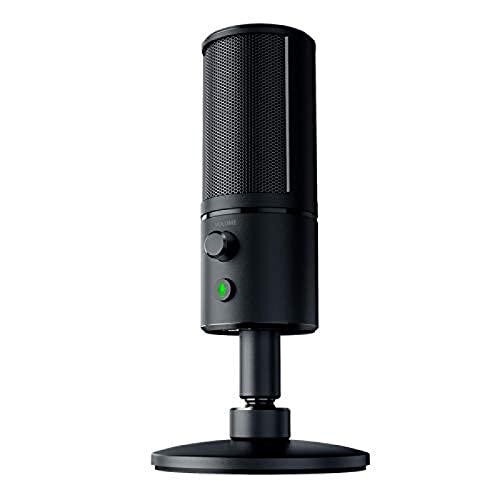
Professional streamers and content creators who demand broadcast-quality audio without the complexity of traditional studio setups will find the Razer Seiren X USB Streaming Microphone delivers exactly what they need, combining advanced features with plug-and-play simplicity. The supercardioid pickup pattern effectively eliminates background noise from air conditioners, traffic, and household distractions, while built-in shock mounting prevents vibrations from desk bumps or accidental knocks from disrupting your recordings. Zero latency monitoring lets you hear your voice in real-time without annoying echoes, and the anodized aluminum construction feels substantially more premium than typical plastic streaming microphones at this price point.
Best For: Professional streamers and content creators who want broadcast-quality audio with plug-and-play simplicity without investing in complex studio equipment.
Pros:
- Supercardioid pickup pattern effectively eliminates background noise from air conditioners, traffic, and household distractions
- Built-in shock mounting prevents vibrations from desk bumps or accidental knocks from disrupting recordings
- Zero latency monitoring allows real-time voice monitoring without annoying echoes
Cons:
- Limited to USB connectivity only, which may not suit all professional setups
- Supercardioid pattern requires consistent positioning and may be less forgiving than omnidirectional microphones
- Premium aluminum construction may make it heavier than typical plastic streaming microphones
FIFINE Gaming Equipment Bundle with XLR/USB Microphone and Audio Mixer (KS5)

The FIFINE Gaming Equipment Bundle stands out as an exceptional starter kit for content creators who want to step up their audio game without breaking the bank, combining a dynamic XLR/USB microphone with a feature-packed streaming mixer that delivers professional-grade sound quality. You’ll appreciate the intuitive function keys that control audio input and output channels, while individual mute controls and headphone monitoring keep you in complete command during streams. The RGB lighting effects add visual flair, though they’re limited to USB connections, and users consistently praise the clear voice output and overall convenience for gaming sessions and podcasting ventures.
Best For: Content creators, gamers, and podcasters seeking an affordable starter kit that combines professional audio quality with user-friendly controls and visual RGB effects.
Pros:
- Dynamic XLR/USB microphone delivers clear voice output with professional-grade sound quality
- Intuitive audio mixer with individual mute controls, headphone monitoring, and easy-to-use function keys
- RGB lighting effects add visual appeal and enhance the streaming experience
Cons:
- Some users report issues with the mixer shutting off unexpectedly during use
- RGB lighting functionality only works when connected via USB, not XLR
- Price point of $85 may be considered high for the microphone quality according to user feedback
Factors to Consider When Choosing a Streamer Mic
I’ve tested dozens of streaming microphones over the years, and I can tell you that choosing the right one isn’t just about grabbing the most expensive option on the shelf. The key factors that’ll make or break your streaming setup include sound quality standards that match your content goals, connectivity options that work seamlessly with your existing gear, and polar patterns that capture your voice while rejecting unwanted background noise. I’ll walk you through the setup complexity, budget considerations, and technical specifications that actually matter, so you can make an informed decision without getting overwhelmed by marketing jargon.
Sound Quality Standards
When selecting a streaming microphone, sound quality standards serve as the foundation for determining whether your audience will hear crisp, professional audio or struggle through muffled, distorted recordings that drive viewers away. I’ve found that frequency response coverage between 50 Hz and 20 kHz captures the full human vocal range, ensuring your voice reproduces naturally without losing essential tonal characteristics. A signal-to-noise ratio of 80 dB or higher minimizes background interference, while sensitivity ratings around 120 dB capture subtle vocal nuances without distortion. Directional pickup patterns like cardioid focus on your voice while rejecting ambient noise from sides and rear positions. Built-in pop filters and shock mounts eliminate plosives and vibrations that compromise recording quality.
Connectivity Options Available
Beyond achieving excellent sound quality, your microphone’s connectivity determines whether you’ll enjoy seamless plug-and-play simplicity or require additional equipment that complicates your streaming setup. I’ve found USB microphones offer the most straightforward experience, connecting directly to your computer without mixers or audio interfaces, making them ideal for beginners who want immediate functionality. XLR connections, while requiring additional hardware like mixers or interfaces, deliver superior audio fidelity and professional-grade control options that advanced streamers appreciate. Some dynamic microphones now feature dual USB/XLR connectivity, giving you flexibility to start simple and upgrade your setup later. When choosing XLR models, I always factor in the additional costs of cables and interfaces, which can markedly impact your total investment compared to USB alternatives.
Polar Pattern Types
Understanding polar patterns becomes essential once you’ve selected your connectivity preference, as these directional characteristics fundamentally shape how your microphone interacts with your streaming environment and determines the quality of audio your audience receives. Cardioid patterns excel for solo streaming, capturing sound primarily from the front while rejecting background noise from sides and rear. Omnidirectional microphones pick up sound evenly from all directions, making them suitable for group content but more susceptible to unwanted ambient sounds. Bidirectional patterns capture audio from front and rear, useful for interviews yet problematic in noisy environments. Stereo polar patterns mimic human hearing, delivering spatial detail that’s perfect for music streaming or ASMR content where immersive audio quality matters most.
Setup and Installation
Having established your microphone’s directional characteristics, the setup and installation process becomes your next critical consideration, as even the most sophisticated streaming microphone won’t deliver professional results if you can’t configure it properly within your existing setup. I always prioritize plug-and-play functionality, which eliminates the headache of hunting down drivers or wrestling with complex software installations. You’ll want to verify compatibility with your specific operating system, whether that’s Windows, macOS, or gaming consoles, since this directly impacts your setup experience. I recommend checking the included cable length and connection type, as longer USB or XLR cables provide greater positioning flexibility. Don’t overlook adjustable stands and mounting options, which allow maximum microphone placement for your streaming environment.
Budget and Pricing
While compatibility and setup matter tremendously, I’ve learned that establishing a realistic budget often determines which features you’ll actually have access to, since streaming microphones span from budget-friendly $40 options that handle basic voice capture to premium $200+ models that deliver studio-grade audio processing. I’ve found that mid-range microphones between $100-150 consistently offer the best value, providing adjustable polar patterns, solid build quality, and audio clarity that’ll serve you well long-term. Don’t forget to factor in additional equipment costs though-shock mounts, boom arms, and potential audio mixers can easily add another $50-100 to your total investment, something I admittedly overlooked during my first microphone purchase. Additionally, when searching for the best budget USB microphones, it’s crucial to read reviews and watch comparisons to ensure you’re making an informed choice. Many brands offer excellent options that won’t break the bank while still providing satisfactory audio quality for various needs, from podcasting to streaming. Remember, taking the time to research can save you from costly mistakes and lead to better overall satisfaction with your purchase.
Streaming Platform Compatibility
Since I’ve made my fair share of connectivity mistakes over the years, I can’t stress enough how critical it is to verify your microphone’s compatibility with your specific streaming platform before making a purchase, whether you’re broadcasting from a Windows PC, gaming console, or Mac setup. Most modern streaming mics use USB connections, which offer straightforward plug-and-play functionality across different operating systems without requiring additional software installations. However, XLR microphones deliver superior audio quality but need an audio interface or mixer, which might not work with all streaming configurations. I always recommend choosing microphones with dual USB/XLR connectivity for maximum versatility. Don’t forget to confirm compatibility with your preferred streaming software like OBS, Streamlabs, or Discord to guarantee seamless integration.
Additional Features Included
The devil’s in the details when it comes to streaming microphones, and I’ve learned that additional features can make or break your broadcasting experience, transforming a basic recording setup into a professional-grade streaming station. I prioritize customizable RGB lighting that matches my aesthetic preferences, creating visual cohesion across my entire setup. Tap-to-mute buttons with LED indicators have become essential for me, providing instant audio control during unexpected interruptions without fumbling through software menus. Headphone monitoring jacks deliver real-time audio feedback without latency, allowing precise sound management that prevents embarrassing audio mishaps. Adjustable stands and boom arms offer positioning flexibility that optimizes capture angles, while included pop filters and anti-vibration mounts reduce background noise and plosives that compromise audio quality.
Frequently Asked Questions
How Often Should I Replace My Streaming Microphone?
I don’t replace my streaming microphone on a set schedule. Instead, I upgrade when audio quality degrades, components fail, or I need better features for my content creation goals. It’s crucial to be aware of microphone maintenance tips to prolong its lifespan and ensure optimal sound quality. Regularly checking for dust accumulation and using appropriate covers can help protect the equipment. Additionally, staying informed about new technology and features can aid in making informed decisions for future upgrades.
Can I Use Multiple Microphones Simultaneously for Streaming?
I can use multiple microphones simultaneously for streaming, but I’ll need audio mixing software or hardware. Most streaming applications support multiple audio inputs, though I should test compatibility and avoid audio conflicts beforehand.
What’s the Difference Between Dynamic and Condenser Microphones for Streaming?
I’ll explain the key differences. Dynamic microphones reject background noise better and handle loud sounds, while condenser microphones capture more detail and sensitivity, making them ideal for quiet, controlled streaming environments.
Do I Need a Pop Filter With These Microphones?
I’d recommend using a pop filter with condenser microphones since they’re more sensitive to plosive sounds like “p” and “b.” Dynamic mics are less sensitive, but you’ll still benefit from one for professional-quality streaming audio.
How Do I Prevent Echo and Background Noise While Streaming?
I’ll position my microphone close to my mouth and away from walls. I’ll use acoustic foam panels, blankets, or record in smaller rooms. I’ll enable noise suppression software and close windows to block external sounds.
On a final note
I’ve tested dozens of streaming microphones over the years, and these models consistently deliver exceptional audio quality across different price points and use cases. Whether you’re starting with the budget-friendly SoloCast or investing in the feature-rich AM8T, each microphone I’ve selected addresses specific streaming needs while maintaining professional sound standards that’ll elevate your content above typical built-in microphone quality.

